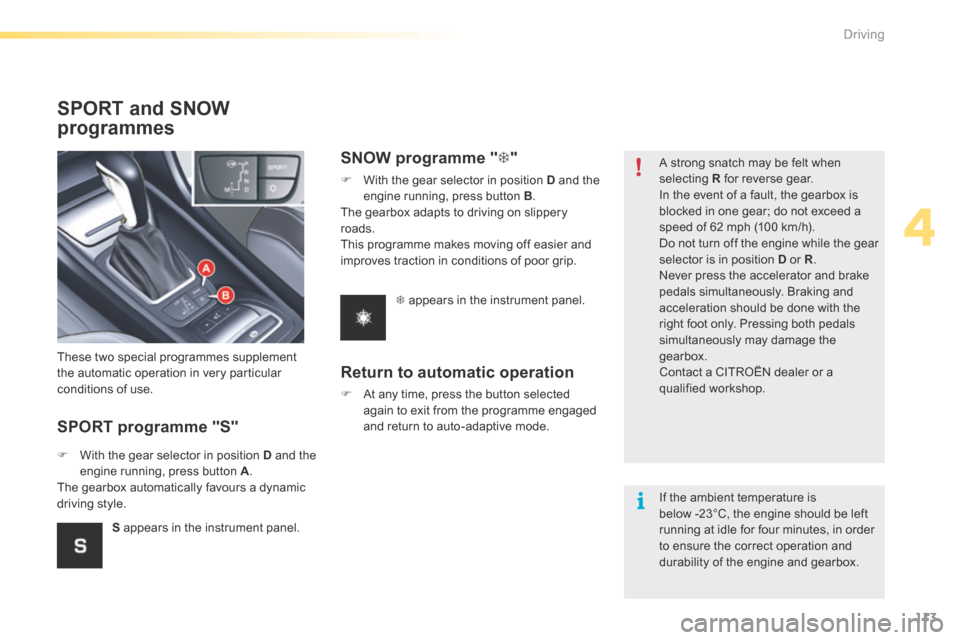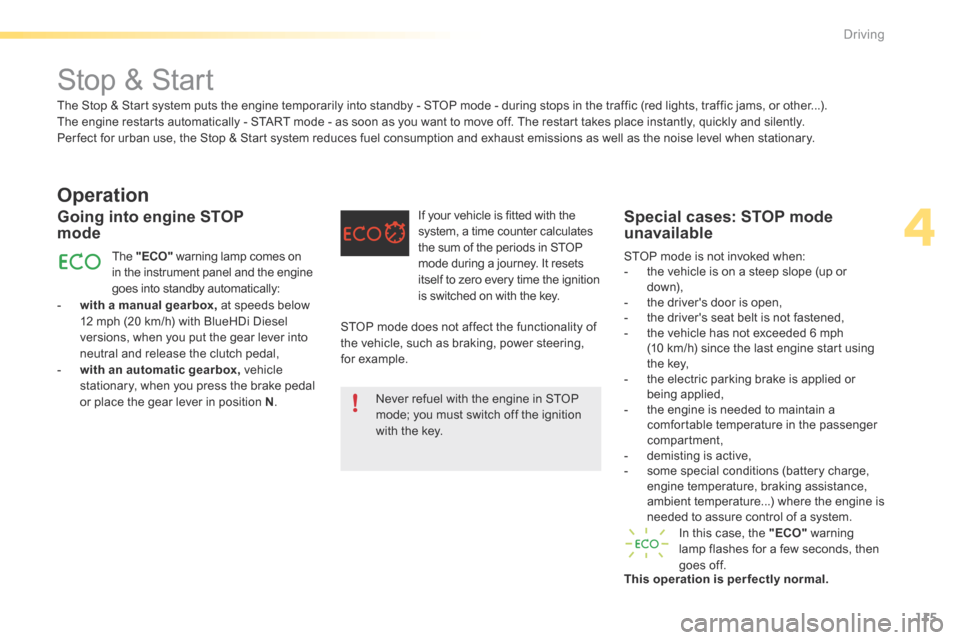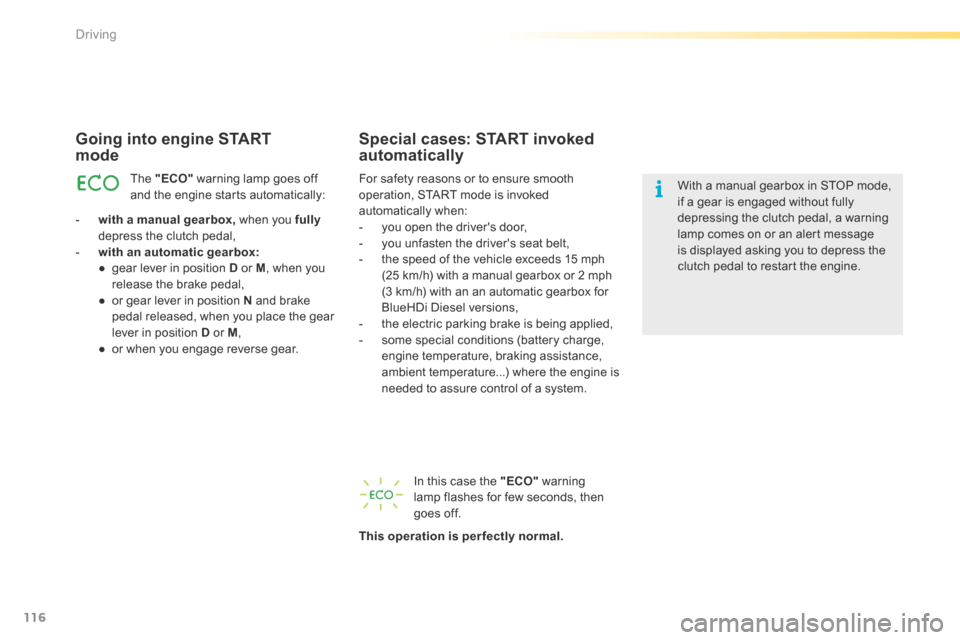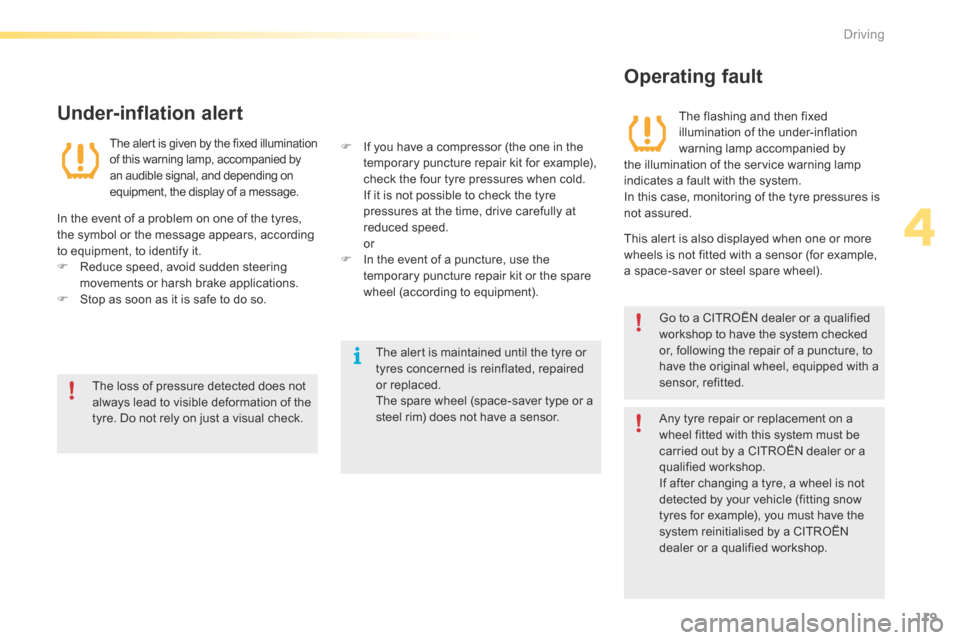brake Citroen C5 2016 (RD/TD) / 2.G Owner's Guide
[x] Cancel search | Manufacturer: CITROEN, Model Year: 2016, Model line: C5, Model: Citroen C5 2016 (RD/TD) / 2.GPages: 366, PDF Size: 30.93 MB
Page 108 of 366

106
C5_en_Chap04_conduite_ed01-2015
SITUATIONCONSEQUENCES
1 Electric parking brake problem and display of message
"
Parking brake faulty " and the following warning
lamps: If the electric parking brake problem warning lamp and the service warning
lamp come on, position the vehicle in a safe location (on flat ground, with a gear
engaged).
2 Display of the messages "
Parking brake faulty" and
" Anti roll-back fault" and of the following warning
lamps : -
The automatic functions are deactivated.
- The hill start assist is not available.
- The electric parking brake is only available manually.
3 Display of messages "
Parking brake faulty" and "Anti
roll-back fault" and of the following warning lamp : -
Manual release of the electric parking brake is not available.
- The hill start assist is not available.
- The automatic functions and manual application are still available.
If any of these instances arises, contact a CITROËN dealer or a qualified workshop as soon as possible.
Operating faults
Driving
Page 109 of 366

107
C5_en_Chap04_conduite_ed01-2015
SITUATIONCONSEQUENCES
4 Display of messages "
Parking brake faulty" and "Anti
roll-back fault" and of the following warning lamps:
and/or flashing -
The automatic functions are deactivated.
- The hill start assist is not available.
To apply the electric parking brake:
F Immobilise the vehicle and switch off the ignition
F Pull the control lever for at least 5 seconds or until maximum application.
F Switch on the ignition and check that the electric parking brake warning lamps
are on.
- Application may take longer than in normal operation.
- If warning lamp (!) flashes or if the warning lamps do not come on when the
ignition is switched on, this method does not work. Have it checked by a
CITROËN dealer or a qualified workshop.
To release the electric parking brake:
F Switch on the ignition.
F Push the control lever and hold it for approximately 3 seconds.
5 Display of message "
Parking brake control faulty –
automatic mode activated " and the following warning
lamps:
and/or flashing -
Only the functions for automatic application on switching off the engine and
automatic release on acceleration are available.
- Manual application/release of the electric parking brake and dynamic
emergency braking are unavailable.
6 Display of message "
Parking brake faulty " and of the
following warning lamp:
flashing -
Application of the parking brake is not guaranteed.
- The parking brake is temporarily unavailable.
It this situation arises:
F Wait approximately 3 minutes.
F After 3 minutes, if the warning lamp is still flashing, try to reinitialise the parking
brake, either by pushing and releasing the control A while pressing the brake
pedal or by means of a long pull on control lever A .
7 Battery problem
- Illumination of the battery warning lamp makes it essential to stop the vehicle
as soon as traffic allows. Stop and immobilise your vehicle.
- Apply the electric parking brake before switching off the engine.
4
Driving
Page 110 of 366

108
C5_en_Chap04_conduite_ed01-2015
Hill start assist
System which keeps your vehicle immobilised
temporarily (approximately 2 seconds) when
starting on a gradient, the time to move your
foot from the brake pedal to the accelerator
pedal.
This function is only active when:
- the vehicle is completely stationary, with
your foot on the brake pedal,
- in certain conditions on a gradient,
- with the driver’s door closed.
The hill start assist function cannot be
deactivated.Operation
On an ascending gradient, with the vehicle
stationar y, the vehicle is held for a brief
moment when you release the brake pedal:
- provided you are in first gear or neutral on
a manual gearbox,
- provided you are in D or M on an automatic
gearbox. On a descending gradient, with the vehicle
stationary and reverse gear engaged, the
vehicle is held for a brief moment when you
release the brake pedal.
Do not exit the vehicle while it is being
held in the hill start assist phase.
If you need to leave the vehicle with the
engine running, apply the parking brake
manually and ensure that the parking
brake warning lamp (in the instrument
panel) is on fixed (not flashing).
driving
Page 112 of 366

110
C5_en_Chap04_conduite_ed01-2015
Mode selectionDisplays in the instrument panel
F Automatic mode: gear selector in
position D.
F Manual mode: gear selector in position M .
F SPORT programme: gear selector in
position D and button A pressed,
F SNOW programme: gear selector in
position D and button B pressed. The position of the gear selector and the driving
mode are displayed in the right hand dial of the
instrument panel.
A position grille associated with the gear selector
allows you to view the selected position.
Automatic gearbox
Automatic gearbox which offers a choice
between the comfort of fully automatic
operation, enhanced by the sport and snow
programmes, or manual gear changing.
Two driving modes are provided:
-
automatic operation for electronic control
of the gears by the gearbox, associated
with:
● a SPORT programme for a more
dynamic driving style,
● a SNOW programme to improve driving
when the grip is poor,
- manual operation for sequential changing
of the gears by the driver. As a safety measure:
- position
P can be disengaged only
by pressing the brake pedal,
- when a door is opened, an audible
signal is heard if the gear selector
is not in position P ,
- always make sure that the gear
selector is in position P before you
leave your vehicle.
If the gearbox is in position P but the
position of the gear selector is different,
reposition the gear selector at P so that
you can start the vehicle.
Driving
Page 113 of 366

111
C5_en_Chap04_conduite_ed01-2015
Moving off
F To start the engine, the gear selector must
be in position P or N .
F Operate the starter.
F When the engine is running, place the gear
selector at R , D or M.
F Check in the instrument panel, the position
engaged.
F Release the brake pedal and accelerate.
F To avoid a possible difference between the
position of the gear selector and the actual
position of the gearbox, always come out
of position P with the ignition on and brake
pedal applied.
Otherwise, when the ignition is on or the engine
is running:
F reposition the gear selector at position P ,
F put your foot on the brake pedal and then
select the gear you want.
Park
This position of the gear selector
is used to prevent the vehicle from
moving when you are stationary.
Reverse gear
Only engage this position when the
vehicle is stationary. To prevent
snatching, do not accelerate too soon
after selection.
Neutral
never select position N if the vehicle
is moving.
F
To select position P , move the gear selector
back to the highest position (towards R ),
then push it for wards and then to the left.
F To exit position P, move the gear selector to
the right and then to the position you want.
F Only engage this position when the vehicle
is completely stationary. In this position,
the front wheels are locked. Make sure that
the gear selector is correctly positioned.
never select position P or R if the
vehicle is not stationary.
If, while the vehicle is moving,
position N is engaged inadvertently,
allow the engine to idle before engaging
position D or M .
4
Driving
Page 115 of 366

113
C5_en_Chap04_conduite_ed01-2015
SPORT and SNOW
programmes
SPORT programme "S"
These two special programmes supplement
the automatic operation in very particular
conditions of use.
F With the gear selector in position D and the
engine running, press button A .
The gearbox automatically favours a dynamic
driving style.
SNOW programme " T"
F With the gear selector in position D and the
engine running, press button B .
The gearbox adapts to driving on slippery
roads.
This programme makes moving off easier and
improves traction in conditions of poor grip.
T appears in the instrument panel.
S appears in the instrument panel.
Return to automatic operation
F At any time, press the button selected
again to exit from the programme engaged
and return to auto-adaptive mode. A strong snatch may be felt when
selecting
R for reverse gear.
In the event of a fault, the gearbox is
blocked in one gear; do not exceed a
speed of 62 mph (100 km/h).
Do not turn off the engine while the gear
selector is in position D or R .
Never press the accelerator and brake
pedals simultaneously. Braking and
acceleration should be done with the
right foot only. Pressing both pedals
simultaneously may damage the
gearbox.
Contact a CITR oËn dealer or a
qualified workshop.
If the ambient temperature is
below -23°C, the engine should be left
running at idle for four minutes, in order
to ensure the correct operation and
durability of the engine and gearbox.
4
Driving
Page 117 of 366

115
C5_en_Chap04_conduite_ed01-2015
Stop & Start
Operation
- with a manual gearbox, at speeds below
12 mph (20 km/h) with BlueHDi Diesel
versions, when you put the gear lever into
neutral and release the clutch pedal,
- with an automatic gearbox, vehicle
stationary, when you press the brake pedal
or place the gear lever in position N .
Going into engine STOP
mode
The "ECO" warning lamp comes on
in the instrument panel and the engine
goes into standby automatically: If your vehicle is fitted with the
system, a time counter calculates
the sum of the periods in STOP
mode during a journey. It resets
itself to zero every time the ignition
is switched on with the key.
Special cases: STOP mode
unavailable
In this case, the "ECO"
warning
lamp flashes for a few seconds, then
goes off.
This operation is perfectly normal. STOP mode is not invoked when:
- the vehicle is on a steep slope (up or
d ow n),
- the driver's door is open,
- the driver's seat belt is not fastened,
- the vehicle has not exceeded 6 mph
(10 km/h) since the last engine start using
the key,
- the electric parking brake is applied or
being applied,
- the engine is needed to maintain a
comfortable temperature in the passenger
compartment,
- demisting is active,
- some special conditions (battery charge,
engine temperature, braking assistance,
ambient temperature...) where the engine is
needed to assure control of a system.
The Stop & Start system puts the engine temporarily into standby - STOP mode - during stops in the traffic (red lights, traffic jams, or other...).
The engine restarts automatically - START mode - as soon as you want to move off. The restart takes place instantly, quickly and silently.
Per fect for urban use, the Stop & Start system reduces fuel consumption and exhaust emissions as well as the noise level when stationary.
STOP mode does not affect the functionality of
the vehicle, such as braking, power steering,
for example.Never refuel with the engine in STOP
mode; you must switch off the ignition
with the key.
4
driving
Page 118 of 366

116
C5_en_Chap04_conduite_ed01-2015
- with a manual gearbox, when you fully
depress the clutch pedal,
- with an automatic gearbox:
● gear lever in position D or M , when you
release the brake pedal,
● or gear lever in position N and brake
pedal released, when you place the gear
lever in position D or M ,
● or when you engage reverse gear.
Going into engine START
mode
The "ECO" warning lamp goes off
and the engine starts automatically:
Special cases: START invoked
automatically
In this case the "ECO" warning
lamp flashes for few seconds, then
goes off.
This operation is perfectly normal. For safety reasons or to ensure smooth
operation, START mode is invoked
automatically when:
- you open the driver's door,
- you unfasten the driver's seat belt,
- the speed of the vehicle exceeds 15 mph
(25 km/h) with a manual gearbox or 2 mph
(3 km/h) with an an automatic gearbox for
blueH di d iesel versions,
- the electric parking brake is being applied,
- some special conditions (battery charge,
engine temperature, braking assistance,
ambient temperature...) where the engine is
needed to assure control of a system. With a manual gearbox in STOP mode,
if a gear is engaged without fully
depressing the clutch pedal, a warning
lamp comes on or an alert message
is displayed asking you to depress the
clutch pedal to restart the engine.
driving
Page 119 of 366

117
C5_en_Chap04_conduite_ed01-2015
Reactivation
Press the "ECO OFF" switch again.
The system is active again; this is confirmed
by the switch warning lamp going off and the
display of a message.The system is reactivated automatically
at every new start using the key.
Operating fault
In the event of a malfunction with the system,
the "ECO OFF" switch warning lamp flashes,
then comes on continuously.
have it checked by a CITROËN dealer or a
qualified workshop.
At any time, press the "ECO OFF" switch to
deactivate the system.
This is confirmed by the switch warning lamp
coming on accompanied by the display of a
message.
Deactivation
If the system has been deactivated
in STOP mode, the engine restarts
immediately.
In the event of a fault in ST
oP
mode, the vehicle may stall. All of
the instrument panel warning lamps
come on.
Depending on version, an alert
message may also be displayed asking
you to put the gear lever into position N
and put your foot on the brake pedal.
It is then necessary to switch off the
ignition, then restart the engine using
the key.
4
Driving
Page 121 of 366

119
C5_en_Chap04_conduite_ed01-2015
The loss of pressure detected does not
always lead to visible deformation of the
tyre. Do not rely on just a visual check.The alert is maintained until the tyre or
tyres concerned is reinflated, repaired
or replaced.
The spare wheel (space-saver type or a
steel rim) does not have a sensor.
Under-inflation alert
The aler t is given by the fixed illumination
of this warning lamp, accompanied by
an audible signal, and depending on
equipment, the display of a message.
In the event of a problem on one of the tyres,
the symbol or the message appears, according
to equipment, to identify it.
F
Reduce speed, avoid sudden steering
movements or harsh brake applications.
F Stop as soon as it is safe to do so. F
If you have a compressor (the one in the
temporary puncture repair kit for example),
check the four tyre pressures when cold.
If it is not possible to check the tyre
pressures at the time, drive carefully at
reduced speed.
or
F In the event of a puncture, use the
temporary puncture repair kit or the spare
wheel (according to equipment).
Operating fault
The flashing and then fixed
illumination of the under-inflation
warning lamp accompanied by
the illumination of the service warning lamp
indicates a fault with the system.
In this case, monitoring of the tyre pressures is
not assured.
This alert is also displayed when one or more
wheels is not fitted with a sensor (for example,
a space-saver or steel spare wheel).
Go to a CITROËN dealer or a qualified
workshop to have the system checked
or, following the repair of a puncture, to
have the original wheel, equipped with a
sensor, refitted.
Any tyre repair or replacement on a
wheel fitted with this system must be
carried out by a CITR oËn dealer or a
qualified workshop.
If after changing a tyre, a wheel is not
detected by your vehicle (fitting snow
tyres for example), you must have the
system reinitialised by a CITROËN
dealer or a qualified workshop.
4
driving